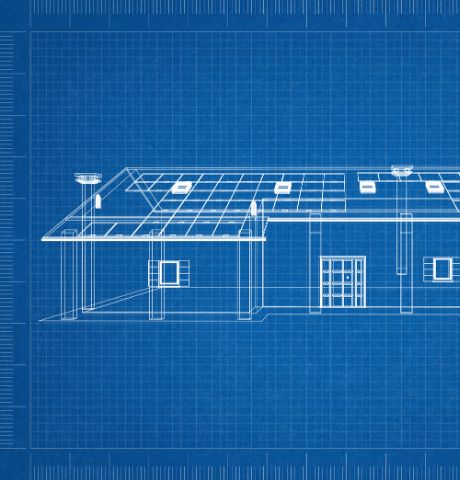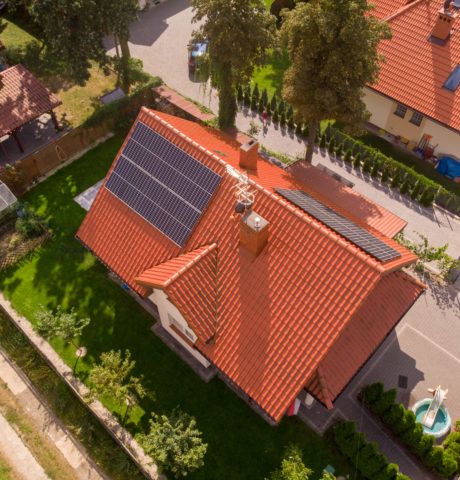What is photovoltaics?
Photovoltaics 101
Fotowoltaika to technologia, która umożliwia produkcję energii elektrycznej ze światła słonecznego. Innymi słowy, to wytwarzanie prądu elektrycznego z promieni słonecznych przy wykorzystaniu zjawiska fotowoltaicznego.
Czyli najkrócej – to prąd ze słońca.
Proces przemiany światła słonecznego na energię elektryczną następuje w ogniwach fotowoltaicznych (panelach fotowoltaicznych). To właśnie one najczęściej są montowane na dachach domów, ale równie dobrze mogą być zainstalowane na ziemi, ścianie budynku, czy… wodzie.
Photovoltaics is, therefore , an affordable and environmentally friendly source of renewable energy, that is becoming increasingly popular. As much as 96% of Poles are satisfied with their photovoltaic installations..
At the end of last year, the number of photovoltaic installations exceeded 845,000 units, and photovoltaics in the renewable energy sector is the largest source of energy (with wind energy being the second largest).
Najlepsze warunki do czerpania energii ze słońca panują w południowo-wschodniej Polsce, w tym m.in. w województwie lubelskim, które jest najbardziej nasłonecznionym regionem w kraju.

96 %
of Poles are satisfied with photovoltaics
PHOTOVOLTAICS OPERATION DIAGRAM
How does Photovoltaics work?
Energia słoneczna jest pochłaniana przez specjalne moduły fotowoltaiczne (panele fotowoltaiczne). To właśnie one zamieniają padające na nie w ciągu dnia promienie słoneczne w prąd stały, który trasą kablową biegnie do kolejnego urządzenia, jakim jest inwerter (falownik). Ten z kolei ma za zadanie zmienić prąd stały w prąd zmienny – czyli taki, z którego korzystamy w domu, pracy, czy praktycznie każdym innym budynku.
PHOTOVOLTAICS INTALLATION OPERATION DIAGRAM
Whats a photovoltaic installation made of?
Jak już wspomnieliśmy na wstępie, fotowoltaika to tani prąd ze słońca. Aby jednak tak było, potrzebna jest instalacja fotowoltaiczna, która składa się z kilku elementów, takich jak: panele fotowoltaiczne, system montażowy, okablowanie, czy inwerter (falownik).
Na ilustracji poniżej możesz zobaczyć, co wchodzi w skład instalacji fotowoltaicznej.

Explanation of devices and components that make up a photovoltaic installation:
- SOLAR PANELS – Convert solar energy into electrical energy.
- INVERTER – Converts DC into AC
- MOUNTING SYSTEM – A system that enables the installation of panels on different types of surfaces and roofs.
- AC AND DC PROTECTION – Protects the internal installation on the direct current and alternating current sides.
- LIGHTNING PROTECTION – Protects the internal installation from voltage surges caused by atmospheric discharges.
- WIRING – A system of cables that connects to the internal network.
OPTIONAL ADDITIONS:
- ENERGY STORAGE – Storage of produced energy.
- HEMS – An intelligent energy management system.
See what photovoltaic installations look in practice
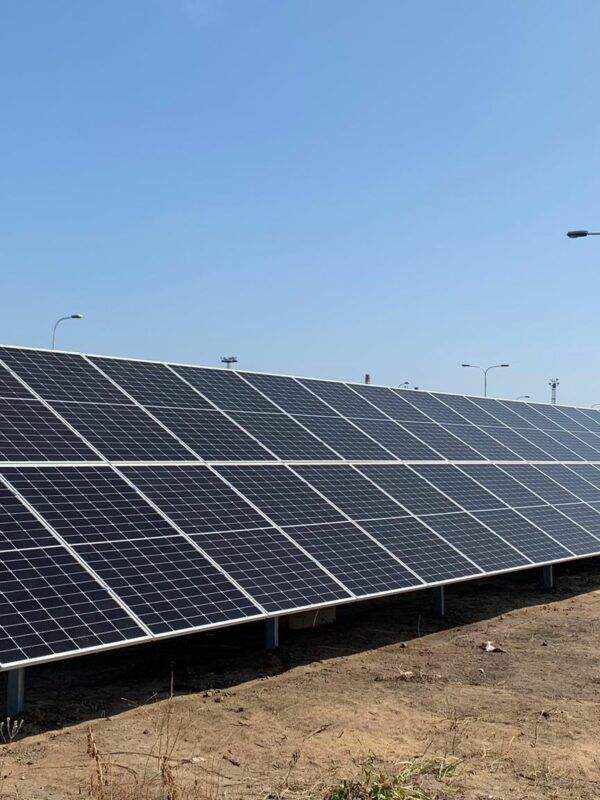




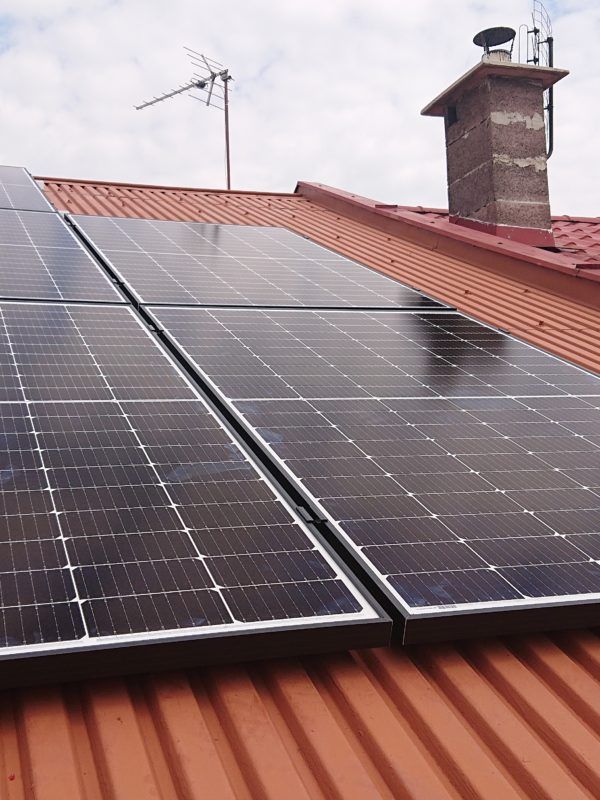


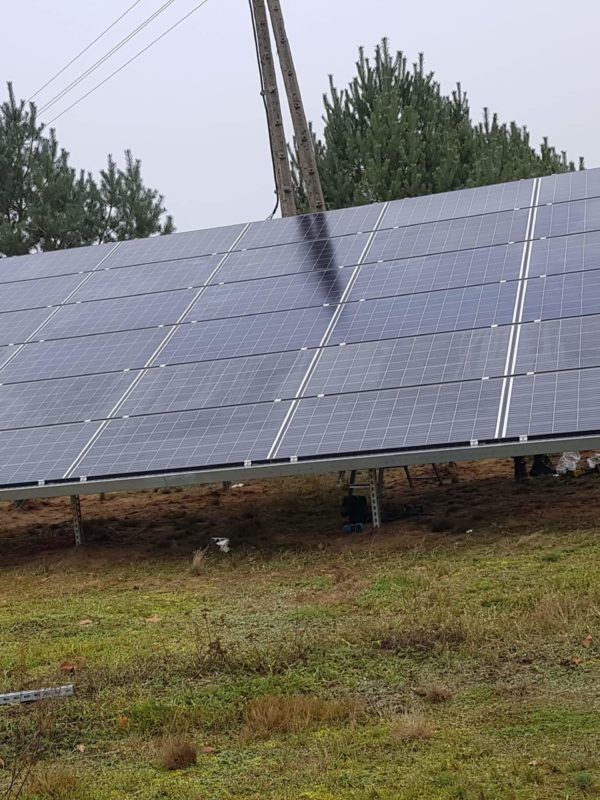








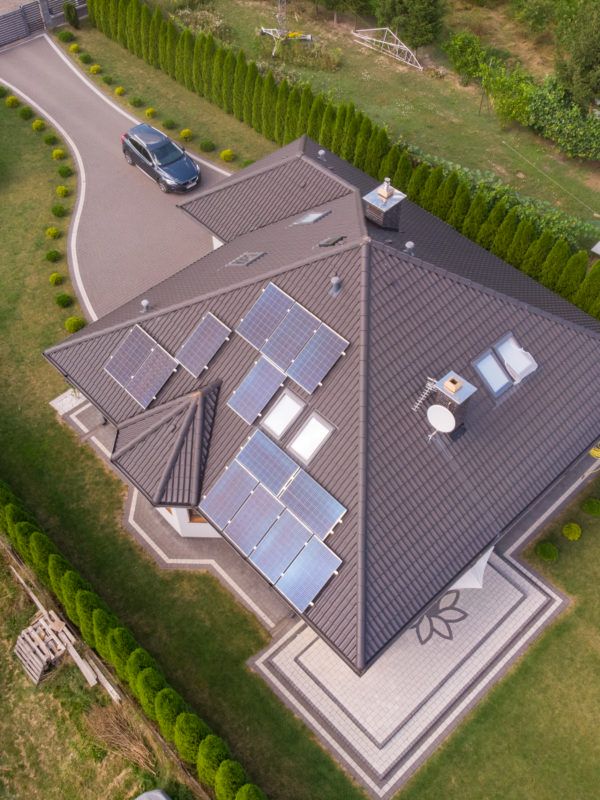
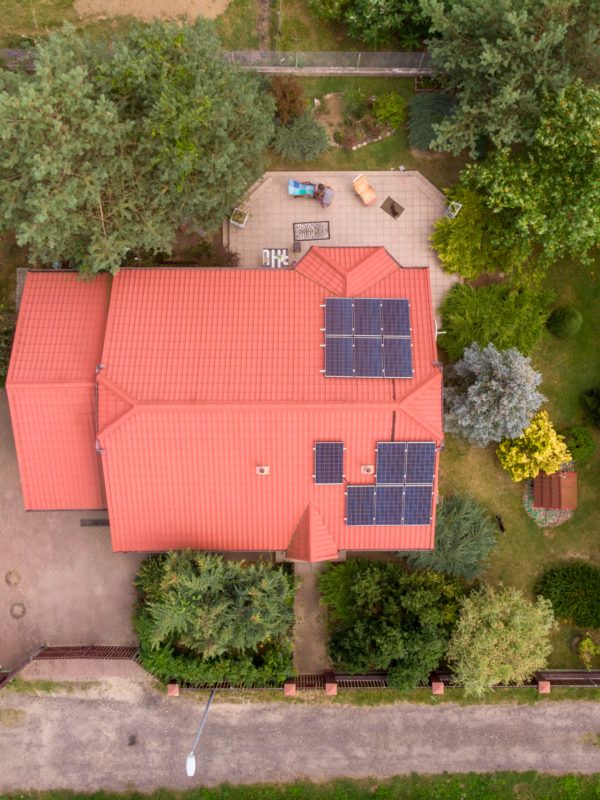

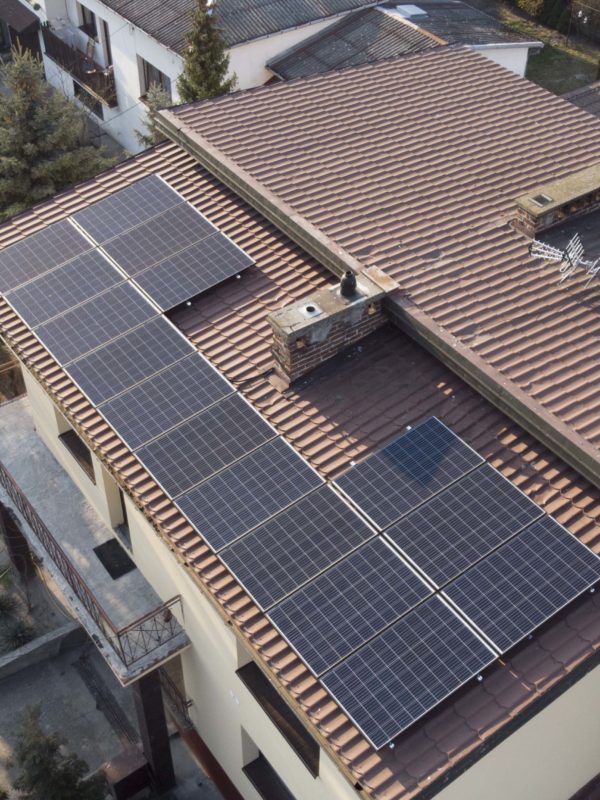


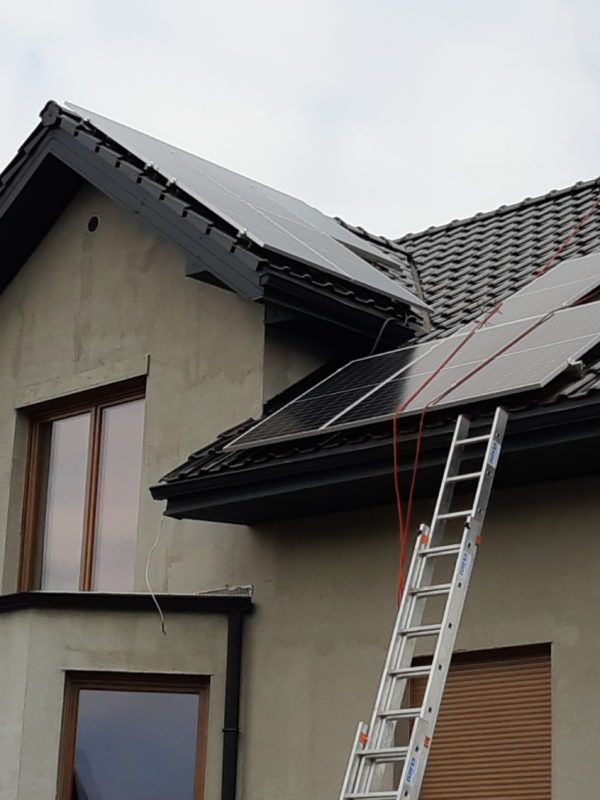




PHOTOVOLTAIC INSTALLATION ELEMENTS – WHAT ARE THEY FOR?
A photovoltaic installation step by step
Photovoltaic Panels. Structure and Key Parameters
Najważniejszymi parametrami opisującymi moduły fotowoltaiczne jest ich sprawność konwersji promieniowania, wyrażana w procentach oraz nominalna moc wyjściowa wyrażana w Wp (Watt peak).
Wp to moc wyjściowa uzyskana z danego modułu przy określonych stałych warunkach testowania, nazywanych STC (z ang. Standard Test Conditions), czyli natężeniu promieniowania 1000 W/m2 i temperaturze otoczenia 25ºC.
A – frame
B – tempered glass
C – EVA film
D – connected photovoltaic cells
E – PET film
F – bottom of the frame
G – junction box

The types of Photovoltaic Cells and Panel Manufacturing Technologies

Monocrystaline Photovoltaic Cell
Made from crystallized silicon.
Characterized by high efficiency, typically ranging from 18-22%, and a higher cost.
They have a distinctive dark color.

Polycrystalline Photovoltaic Cells
Made from crystallized silicon.
Characterized by efficiency ranging from 14-18% and a moderate cost.
They often have a characteristic blue color and clearly defined silicon crystals.

Photovoltaic panel manufactured using Full Black technology.
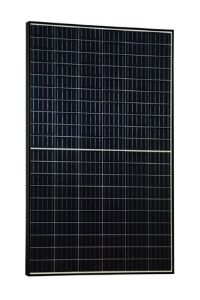
Photovoltaic panel manufactured using Half-Cut technology.

Standard photovoltaic panel.
When Do Cells Form a Photovoltaic Module?
A few or several photovoltaic cells on their own will be too small and weak to generate as much electricity from the sun as an average single-family home consumes in a day.
Only when connected together in series, the cells form photovoltaic modules (solar panels).
W ten sposób moduły tworzą łańcuch, tzw. string, który podpina się do inwertera.

A – photovoltaic module
B – photovoltaic cell
C – modules connected in series (string)
Did you know...
✔️ A standard 330W photovoltaic module weighs approximately 18.6 kg.
✔️ The dimensions of an average photovoltaic module are approximately 1,665 mm in height and 999 mm in width.
✔️ The area occupied by photovoltaic panels for 1 kW is approximately 6.65 square meters.
✔️ The annual electricity production of a 1 kW installation under optimal conditions is 1000 kWh/year.
✔️ An approximate annual electricity consumption for a household of 3300 kWh + 20% can be covered by a photovoltaic installation with a capacity of 4 kW.

Inverter: What Is It and What Are the Types?
Falownik jest najważniejszym z elementów instalacji fotowoltaicznej. Jego zadaniem jest zamiana prądu stałego, produkowanego przez moduły, na prąd zmienny, zsynchronizowany z siecią energetyczną.
Z uwagi na wielkość falowników, a także możliwość podłączenia do nich odpowiedniej liczby paneli, można podzielić je na mikrofalowniki, falowniki stringowe oraz falowniki centralne.
Z uwagi na miejsce montażu spotkać też można inwertery dedykowane do montażu wewnątrz budynku lub na zewnątrz.



Single-Phase and Three-Phase Inverters. What's the Difference?
- Firstly, three-phase inverters positively impact the stability of the local grid at low power.
- Secondly, they experience smaller voltage fluctuations.
- Thirdly, they allow for the use of smaller cable cross-sections.
Island and Grid Inverters. What's the Difference?
- Island inverters , which do not connect to the grid and have the option to connect energy storage
batteries. - Grid inverters , which synchronize with the public grid and feed energy back into the grid but does not
connect to the batteries..
Where Can Inverters Be Installed, and Where They Should Not Be?
Miejsce montażu falownika musi być dobrze przemyślane. Jeśli zamontujemy go na ścianie na zewnątrz budynku i nie zapewnimy mu żadnej ochrony przed słońcem, ryzykujemy przegrzanie urządzenia i jego awarię.
Dlatego producenci zalecają, aby inwerter nie był wystawiany bezpośrednio na słońce.
Najlepiej więc znaleźć osłonięte miejsce np. w okolicy modułów fotowoltaicznych lub umieścić inwerter pod okapem dachu. Producenci odradzają także montaż falowników na strychach i poddaszach z uwagi, że te pomieszczenia w lecie mogą uzyskiwać bardzo wysokie temperatury.
Najczęściej więc falowniki montuje się w piwnicach, garażach lub pomieszczeniach gospodarczych.
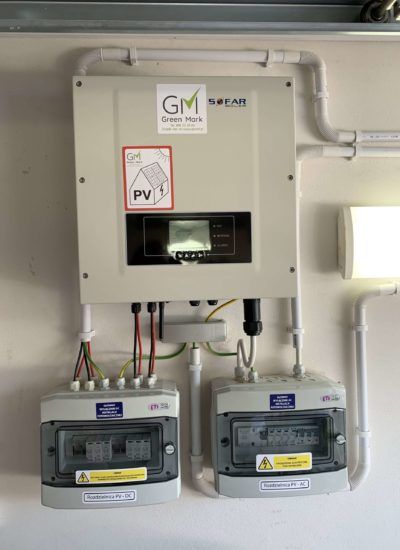
Photovoltaics. Where to Begin?
If you're thinking, "I want to reduce my electricity bills. I want to become less dependent on rising energy prices. I want to ensure a safe energy future for myself, my family, and my children," it means you're ready for photovoltaics.
So, where should you start?
#1 Photovoltaic Audit
A photovoltaic audit involves a discussion with a solar energy specialist who will ask you several specific questions about, for example, your electricity bills or your average annual energy consumption.
Based on the photovoltaic audit, we calculate your energy needs and present a project for the installation. This project includes details such as the placement of panels on the roof, cable routes, and the location of the inverter.
What Does a Photovoltaic Audit Cover?
#2 Photovoltaic Installation Quotation
Once the consultant has gathered essential data from the photovoltaic audit, they will be able to analyze the components and elements of the photovoltaic installation.
The quotation typically includes the cost of photovoltaic panels, accessories, cable routes, the inverter, and the installation itself.
#3 Photovoltaic Installation Draft
After the photovoltaic audit, when you have all the essential data, the consultant returns to the company and shares the collected information, along with roof photos, with the Project Department.
This is where architects create a detailed project for a photovoltaic installation with a specific capacity, taking into account the installation location, cable routes, and inverter placement.
You will have the opportunity to review and approve this project. Once you approve it, you can schedule the installation of your photovoltaic system.
#4 Photovoltaic Installation
After approving the project, you can schedule the installation of your photovoltaic system.
At Green Mark, this typically occurs within 14 days after project approval. During this time, we assemble all the necessary components, the correct number of photovoltaic panels, and so on.
#5 Notifying the Energy Company of the Installed Photovoltaic System
For your installed photovoltaic system to operate efficiently, it must be reported to the energy company. At Green Mark, we assist with the necessary documentation, making this process easy for you.
According to regulations, energy distributors have 30 days to come to your home and install a bidirectional energy meter. Once this is done, your photovoltaic system can start generating electricity from the sun.
#6 Utilizing the "My Electricity" Program
Once your installation is up and running, connected to the power grid, it's time to take advantage of the "Mój Prąd" (My Electricity) subsidy program.
This government program is designed for individuals who generate their electricity for personal use and have a comprehensive agreement (with the Distribution System Operator – DSO) governing the injection of electricity into the grid from a microinstallation.
As Green Mark, we are an authorized partner of the National Fund for Environmental Protection and Water Management. We assist in correctly filling out applications and help you secure funding.
Our applications have a high success rate, meaning they are 99% error-free, filled out correctly, and processed as a priority. With our assistance, you can secure funding almost as easily as through a bank.
Monitorujemy, co dzieje się z III turą naborów Mój Prąd 2021. Kiedy tylko ruszy nabór, jako nasz klient będziesz mógł skorzystać z naszej pomocy w skutecznym złożeniu wniosku i uzyskania dofinansowania.
It's Worth Remembering
Benefits of Photovoltaics
Savings
Safety
Convenience
Environmentally Friendly
Investment
Future
Our consultants are at your disposal. Leave us a message, and we will get back to you promptly.





